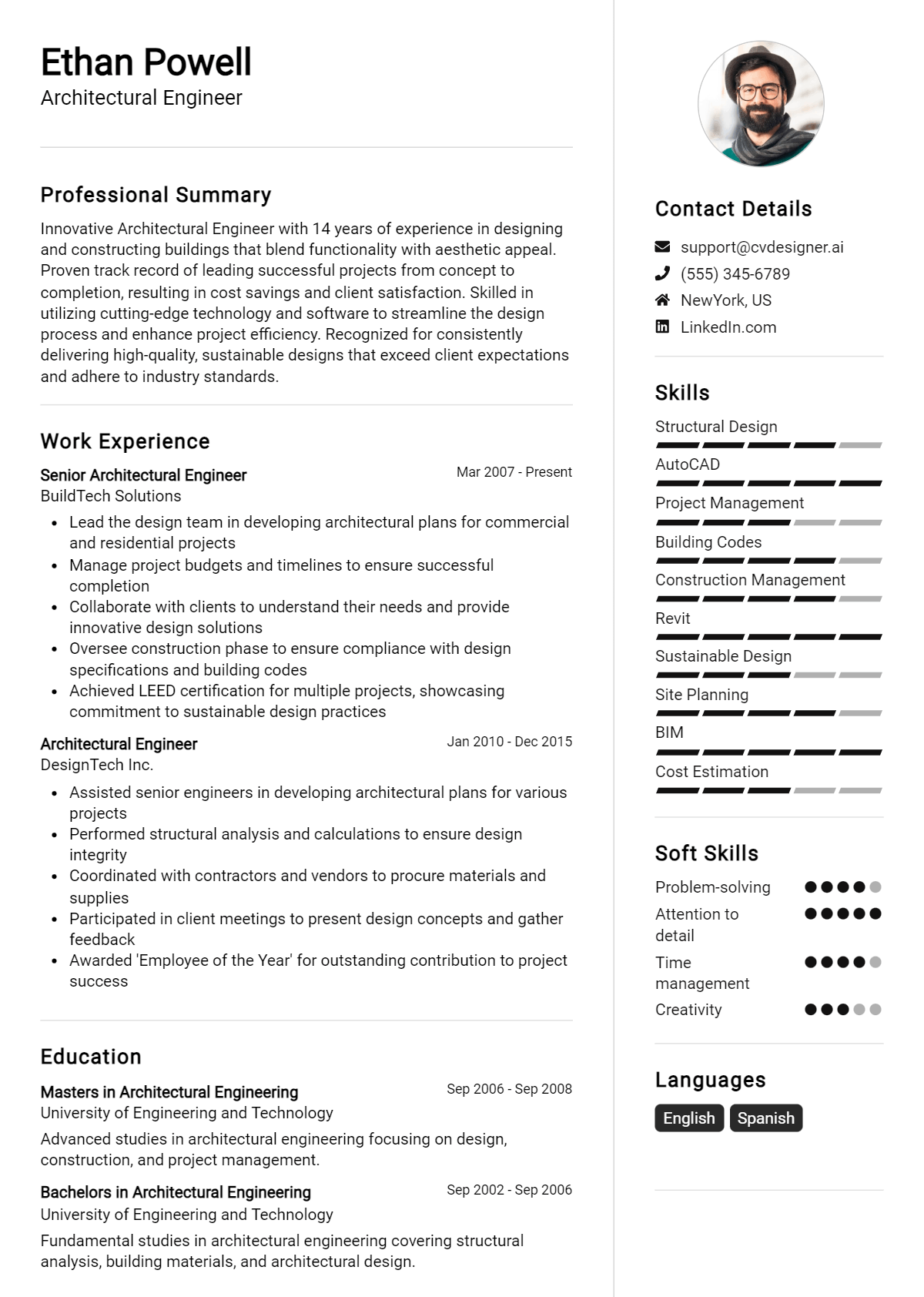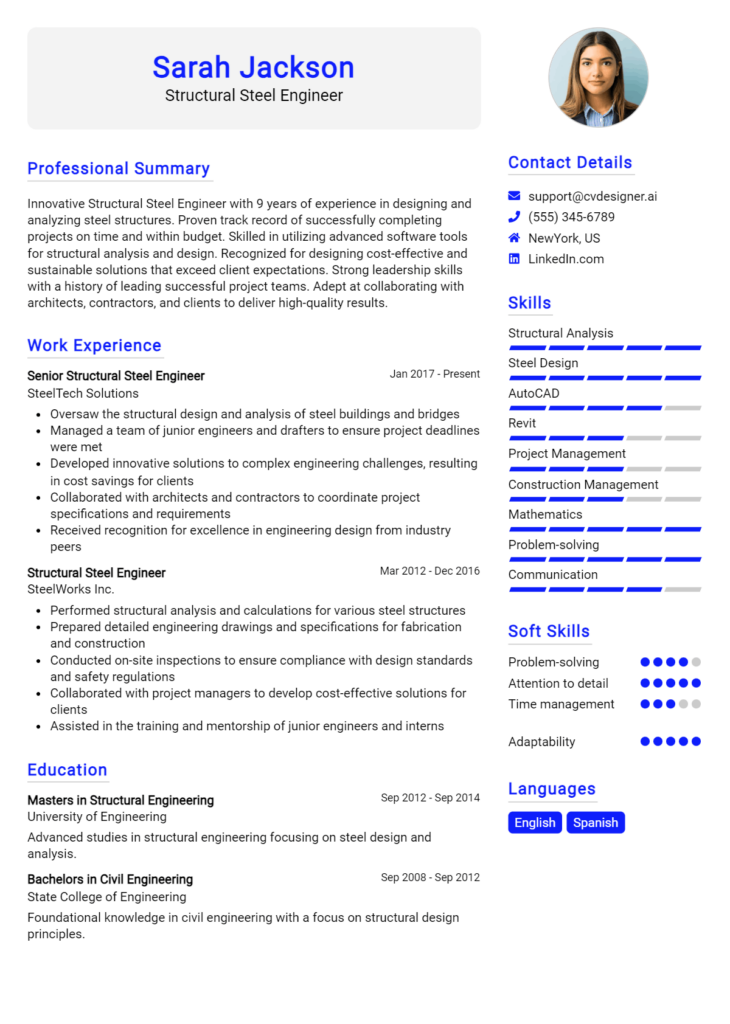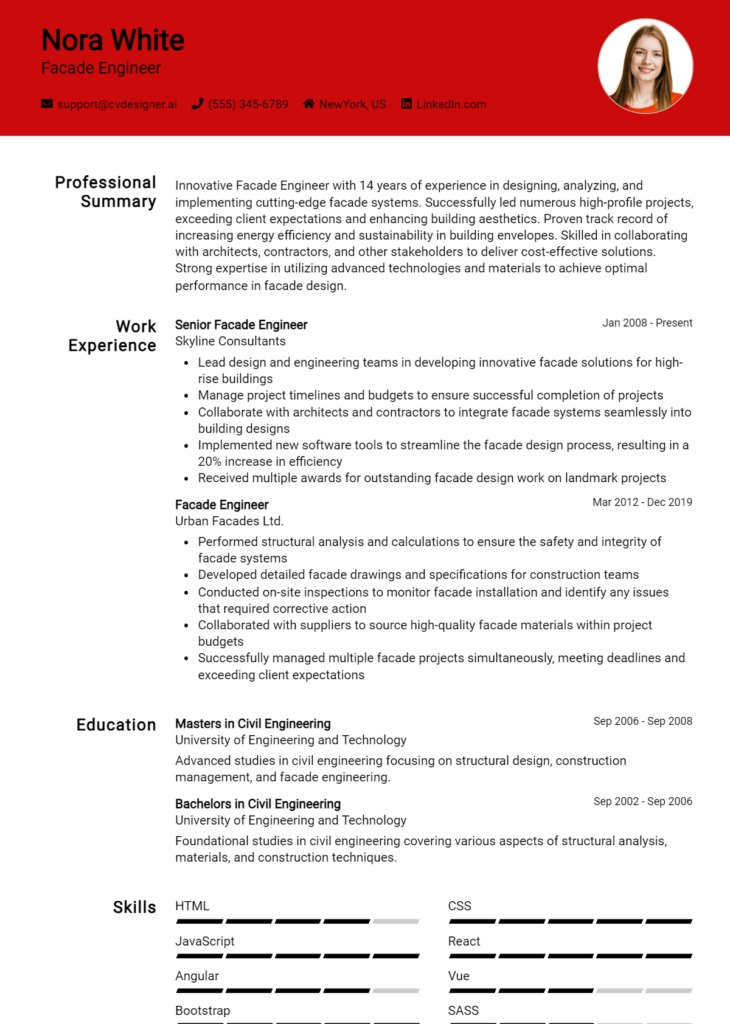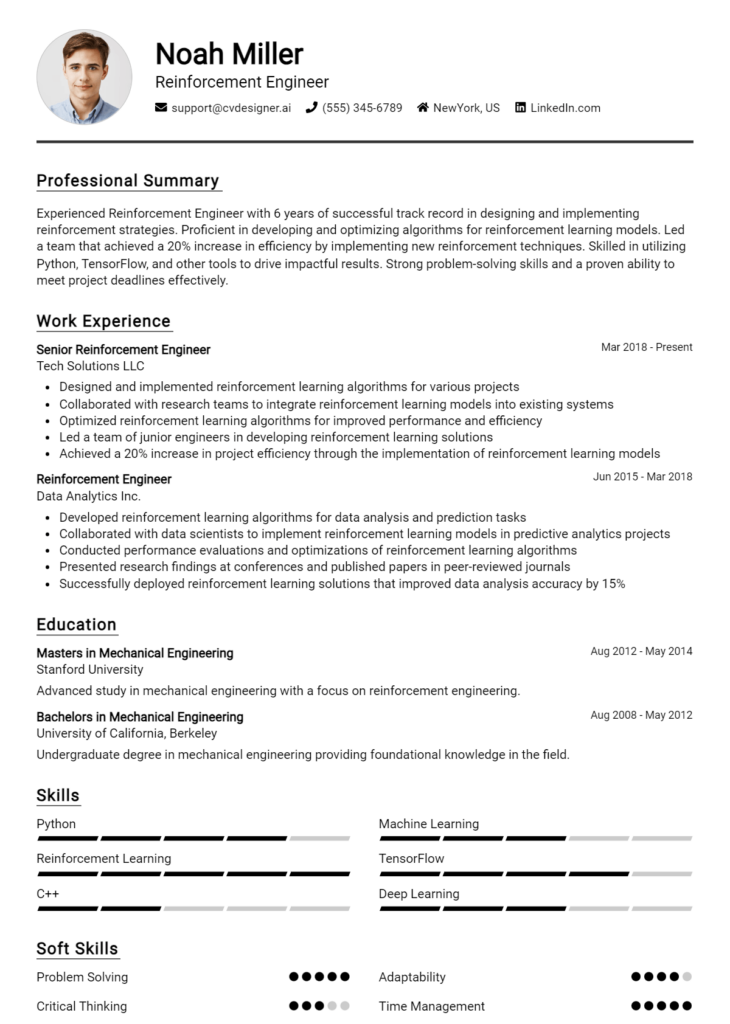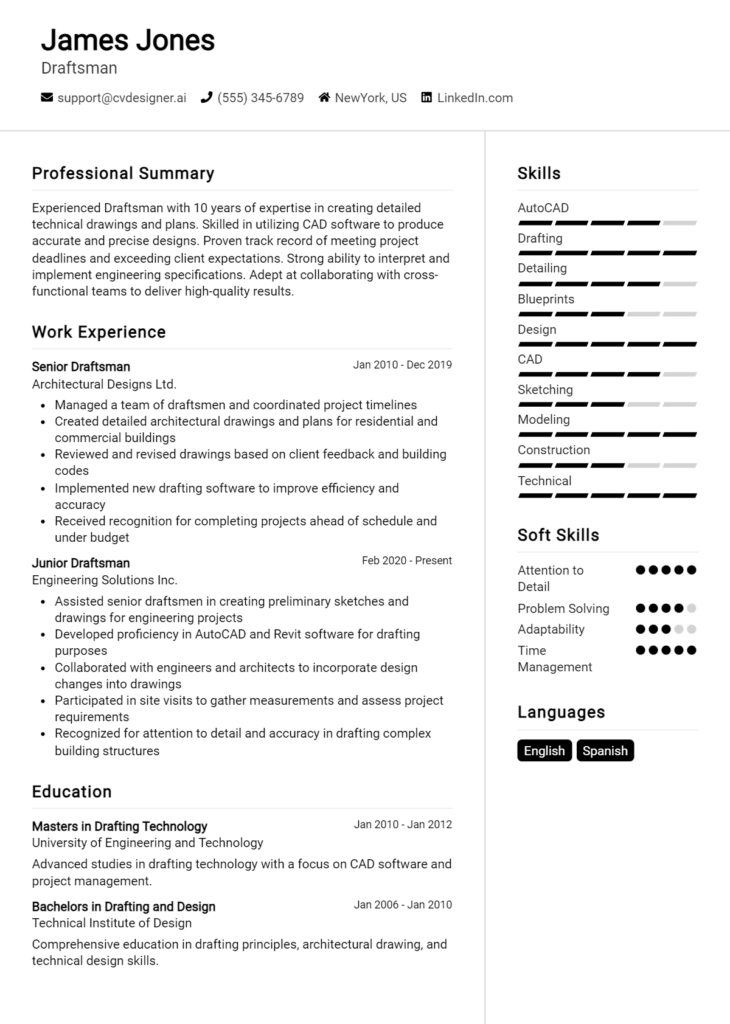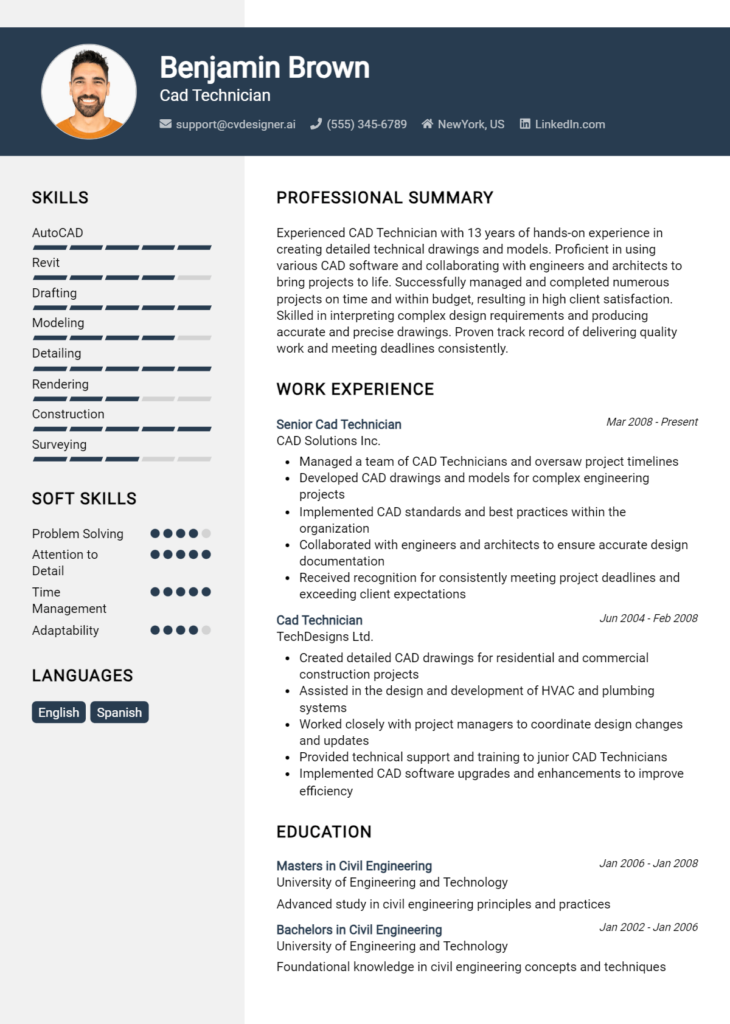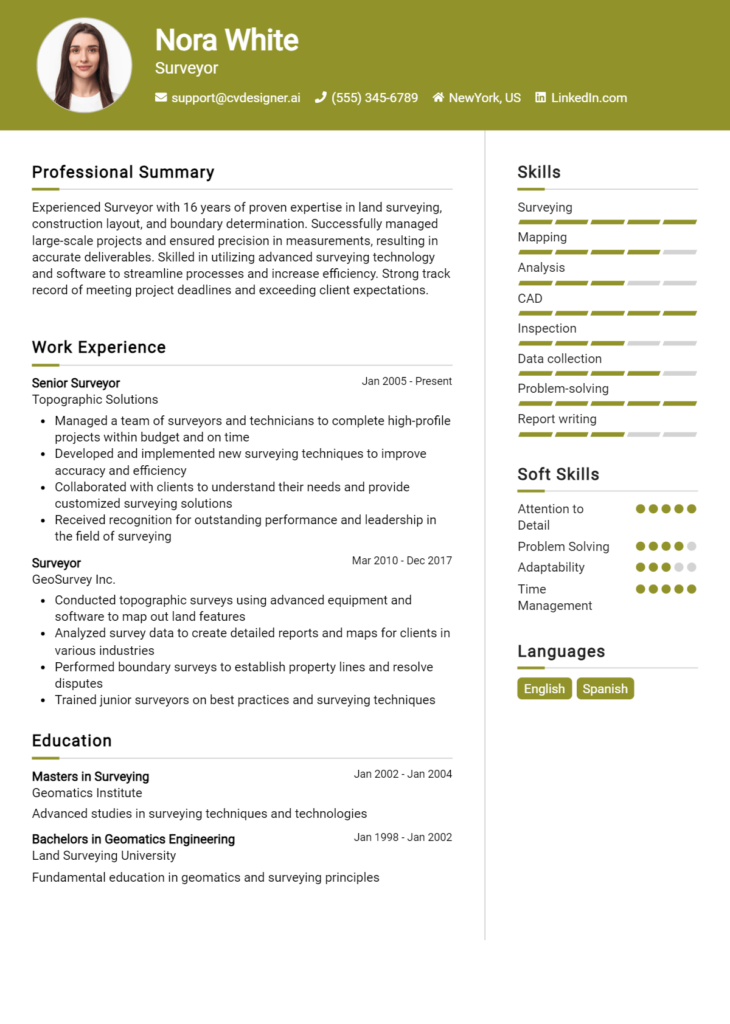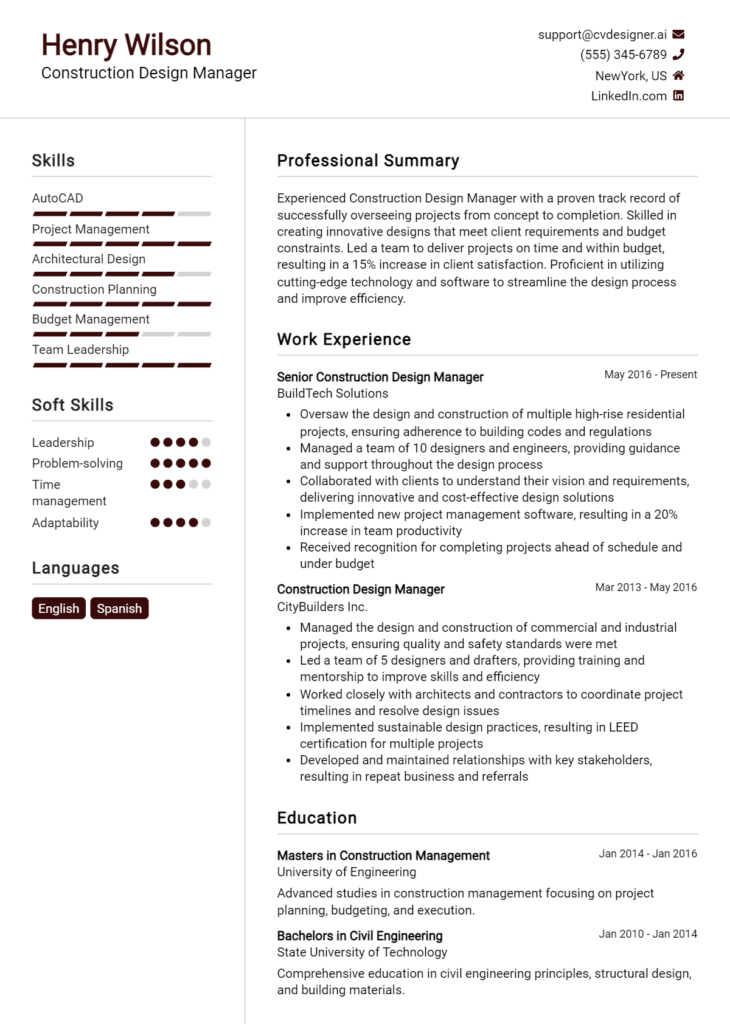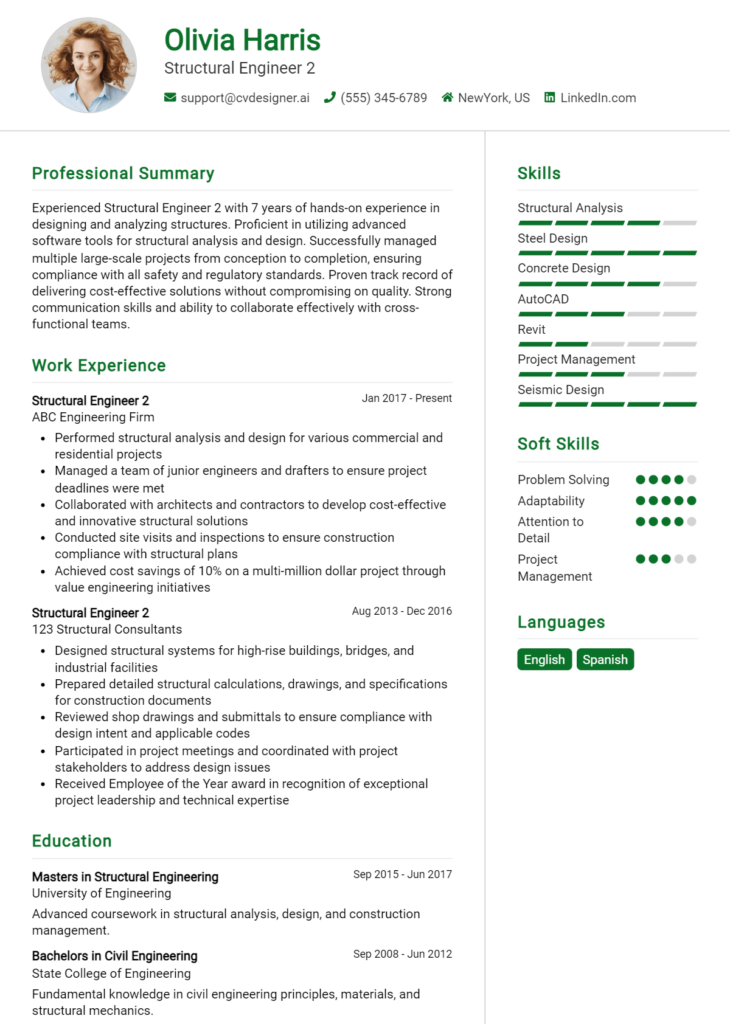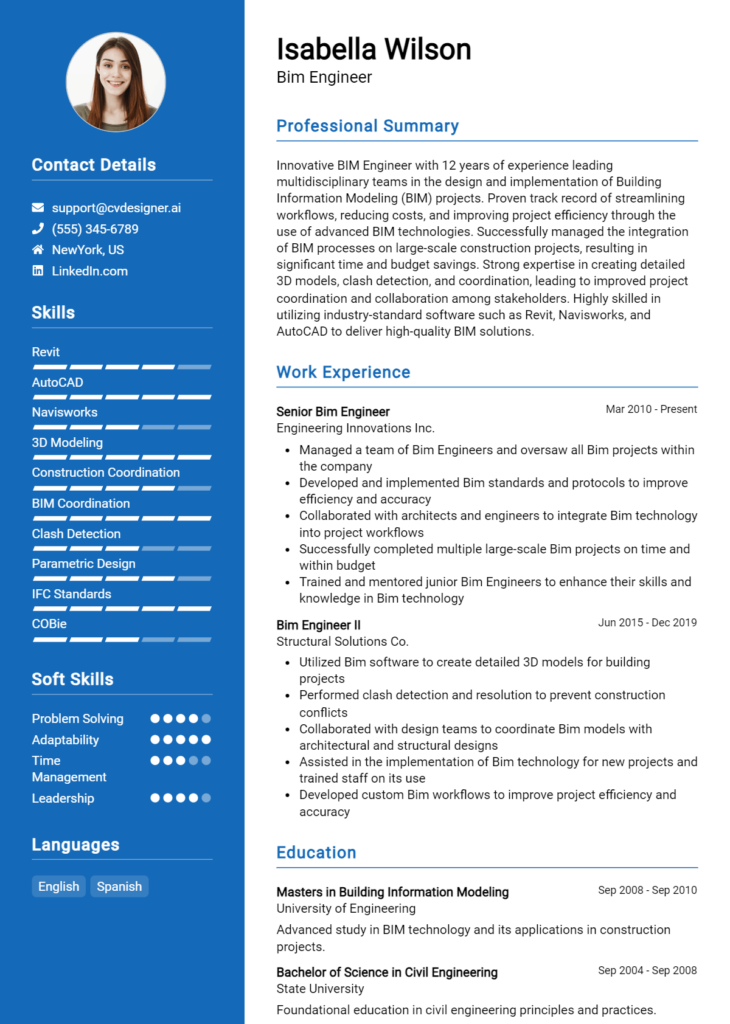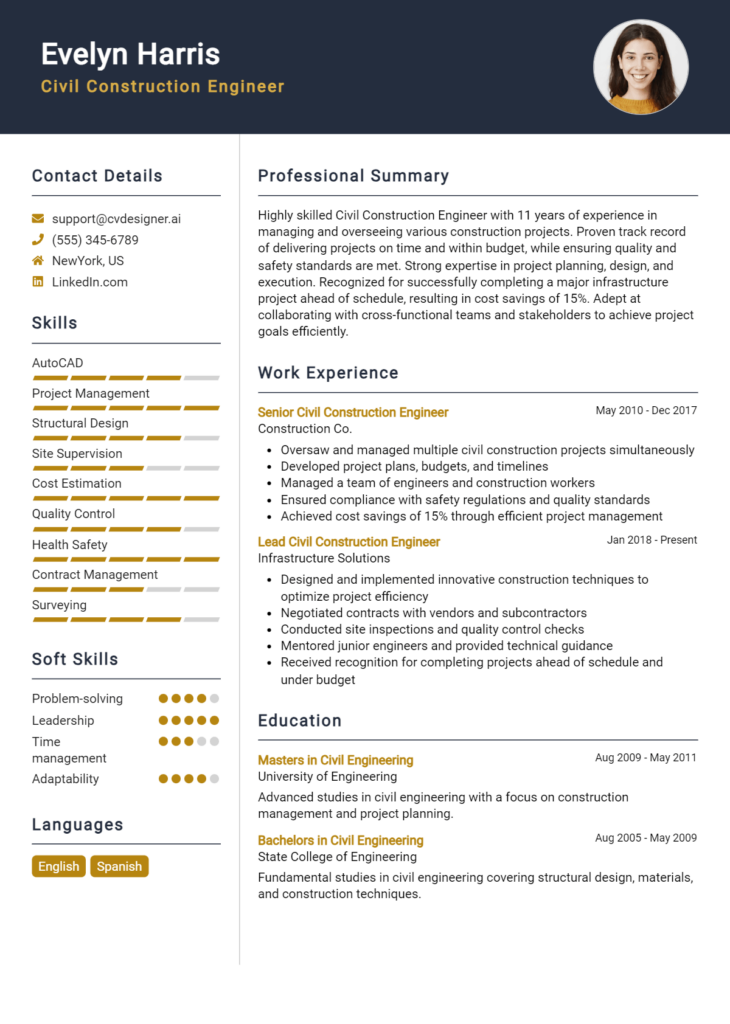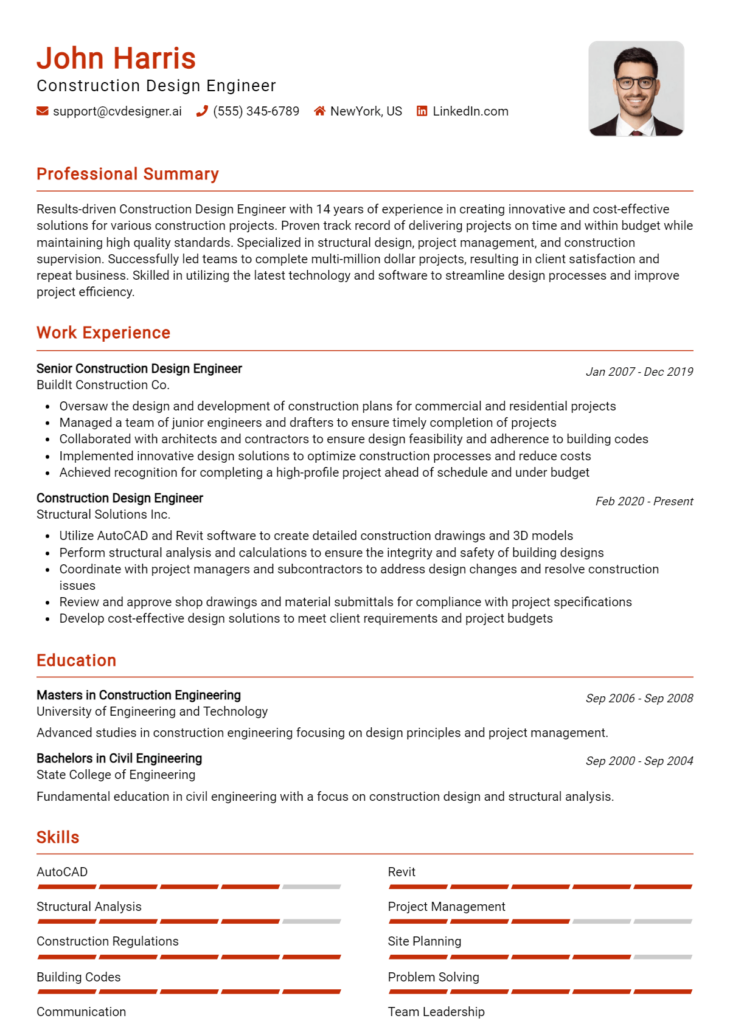Architectural Engineer Core Responsibilities
An Architectural Engineer plays a crucial role in the design and construction of buildings, bridging the gap between architecture and engineering. Key responsibilities include collaborating with architects and construction teams, ensuring structural integrity, and optimizing building systems for efficiency. Essential skills encompass technical expertise, operational knowledge, and strong problem-solving abilities, which contribute significantly to achieving the organization's goals. A well-structured resume is vital to effectively showcase these qualifications and demonstrate a candidate's value to potential employers.
Common Responsibilities Listed on Architectural Engineer Resume
- Collaborate with architects to develop building designs and specifications.
- Conduct structural analysis and design calculations.
- Oversee the construction process to ensure compliance with plans and regulations.
- Develop and maintain project timelines and budgets.
- Coordinate with various departments, including HVAC, electrical, and plumbing.
- Perform site assessments and feasibility studies.
- Utilize CAD software to create detailed drawings and models.
- Review and approve construction documents and shop drawings.
- Ensure adherence to safety standards and building codes.
- Provide technical support and solutions during construction phases.
- Conduct post-construction evaluations and assessments.
- Engage in continuous learning to stay updated on industry trends and technologies.
High-Level Resume Tips for Architectural Engineer Professionals
A well-crafted resume is essential for Architectural Engineer professionals, as it serves as the first impression a candidate makes on potential employers. In a competitive job market, your resume must not only highlight your technical skills and experience but also reflect your achievements in a way that resonates with hiring managers. A strong resume can set you apart from other candidates by showcasing your unique qualifications and demonstrating your fit for the role. This guide will provide practical and actionable resume tips specifically tailored for Architectural Engineer professionals, helping you to craft a document that truly represents your expertise.
Top Resume Tips for Architectural Engineer Professionals
- Tailor your resume to match the specific job description, using keywords that align with the role.
- Highlight relevant experience in architectural design, project management, and engineering principles.
- Quantify your achievements with specific metrics, such as project costs, time savings, or efficiency improvements.
- Showcase industry-specific software proficiency, such as AutoCAD, Revit, or BIM technologies.
- Include a professional summary at the top that encapsulates your career goals and key competencies.
- List certifications, licenses, and memberships in professional organizations related to architecture and engineering.
- Emphasize teamwork and collaboration skills, as architectural projects often require cross-disciplinary cooperation.
- Utilize a clean, organized format with clear headings and bullet points for easy readability.
- Keep your resume concise, ideally one page, unless you have extensive experience that justifies a longer format.
- Proofread your resume for spelling and grammatical errors, ensuring a polished and professional presentation.
By implementing these tips, you can significantly increase your chances of landing a job in the Architectural Engineer field. A well-structured and tailored resume not only demonstrates your qualifications but also conveys your professionalism and commitment to excellence, making you a more attractive candidate to potential employers.
Why Resume Headlines & Titles are Important for Architectural Engineer
In the competitive field of architectural engineering, a well-crafted resume headline or title is crucial for making a strong first impression on hiring managers. A powerful headline serves as a concise summary of a candidate's key qualifications and can instantly capture the attention of recruiters sifting through numerous applications. This brief yet impactful phrase should be relevant to the specific job being applied for, highlighting the applicant's expertise and strengths in architectural engineering. A strong resume headline not only sets the tone for the entire resume but also provides an immediate insight into the candidate’s potential value to the organization.
Best Practices for Crafting Resume Headlines for Architectural Engineer
- Keep it concise: Aim for one impactful phrase that sums up your qualifications.
- Be role-specific: Tailor the headline to the position you are applying for, using relevant terminology.
- Highlight key strengths: Focus on your most impressive skills or achievements that align with the job requirements.
- Use action-oriented language: Incorporate strong verbs that convey your capabilities and contributions.
- Incorporate industry-specific keywords: Use terminology that resonates with hiring managers in architectural engineering.
- Avoid vague language: Steer clear of generic terms that do not provide meaningful insight into your qualifications.
- Be authentic: Ensure that your headline accurately reflects your experience and expertise.
- Test for impact: Ask for feedback from peers or mentors to ensure your headline resonates well.
Example Resume Headlines for Architectural Engineer
Strong Resume Headlines
Innovative Architectural Engineer with 10+ Years of Sustainable Design Experience
Detail-Oriented Structural Engineer Specializing in High-Rise Developments
Award-Winning Architectural Engineer with Expertise in Smart Building Technologies
Proven Track Record in Project Management for Large-Scale Infrastructure Projects
Weak Resume Headlines
Architectural Engineer Looking for Opportunities
Experienced Professional in Engineering
Seeking a Position in Architecture
The strong resume headlines are effective because they are specific, impactful, and convey the candidate’s unique qualifications in a way that resonates with hiring managers. They immediately highlight relevant experience, specialized skills, and noteworthy achievements, which are essential in a competitive job market. In contrast, the weak headlines fail to impress due to their vague and generic nature, lacking the necessary detail to capture attention or communicate the candidate’s true potential. By avoiding non-specific language and focusing on concrete accomplishments, candidates can significantly enhance their chances of standing out in their job applications.
Writing an Exceptional Architectural Engineer Resume Summary
Crafting an exceptional resume summary is crucial for Architectural Engineers as it serves as the first impression a hiring manager will have of a candidate. A strong resume summary quickly captures attention by effectively showcasing key skills, relevant experience, and significant accomplishments that align with the job role. It should be concise yet impactful, drawing on the candidate's strengths and tailoring the content specifically to the position being applied for. A well-written summary not only highlights what makes the candidate a perfect fit but also sets the tone for the rest of the resume.
Best Practices for Writing a Architectural Engineer Resume Summary
- Quantify Achievements: Use numbers and metrics to demonstrate the impact of your work.
- Focus on Skills: Highlight technical skills that are relevant to the position.
- Tailor to Job Description: Customize the summary to reflect the specific requirements of the job you are applying for.
- Keep it Concise: Aim for 3-5 sentences that clearly convey your strengths.
- Use Active Language: Start sentences with strong action verbs to convey confidence.
- Showcase Relevant Experience: Mention specific projects or roles that relate to the job.
- Highlight Certifications: If applicable, include any relevant certifications that enhance your qualifications.
- Demonstrate Problem-Solving Skills: Mention instances where you effectively solved complex architectural challenges.
Example Architectural Engineer Resume Summaries
Strong Resume Summaries
Detail-oriented Architectural Engineer with over 8 years of experience in designing sustainable buildings. Successfully led a team that reduced project costs by 15% while improving energy efficiency ratings by 20% on multiple commercial projects.
Innovative Architectural Engineer with a proven track record of managing over 50 large-scale projects, consistently meeting deadlines and budget constraints. Expertise in CAD software and LEED certification, resulting in a 30% increase in client satisfaction ratings.
Results-driven Architectural Engineer skilled in structural design and project management. Played a key role in a $10 million urban redevelopment project, achieving a 25% reduction in material waste through strategic planning and resource management.
Weak Resume Summaries
Architectural Engineer with experience in various projects. Good at teamwork and communication.
Dedicated professional seeking an opportunity to apply skills in architecture. Open to various roles in engineering.
The examples of strong resume summaries demonstrate specificity, quantifiable outcomes, and direct relevance to the Architectural Engineer role, showcasing the candidates' skills and achievements. In contrast, the weak resume summaries are vague and lack detail, failing to provide a clear picture of the candidates' qualifications or their impact in previous roles. This highlights the importance of crafting a focused and compelling summary that captures the attention of hiring managers.
Work Experience Section for Architectural Engineer Resume
The work experience section of an Architectural Engineer resume is a critical component that effectively demonstrates a candidate's technical skills, project management abilities, and commitment to delivering high-quality results. This section not only highlights the candidate's practical experience in architectural design and engineering but also showcases their capacity to lead teams and collaborate with various stakeholders. By quantifying achievements and aligning their experiences with industry standards, candidates can present themselves as strong contenders who are capable of contributing to innovative projects and driving organizational success.
Best Practices for Architectural Engineer Work Experience
- Highlight relevant technical skills and tools used in projects, such as CAD software, BIM technology, and structural analysis methods.
- Quantify achievements wherever possible, using metrics like project completion time, budget adherence, and sustainability certifications.
- Showcase leadership roles, emphasizing team management, mentoring, and conflict resolution experiences.
- Detail collaboration efforts with architects, contractors, and clients, demonstrating effective communication and teamwork.
- Use action verbs to begin bullet points, creating a dynamic and engaging narrative of past job responsibilities.
- Focus on results-oriented statements that reflect an understanding of industry trends and standards.
- Tailor the work experience to match the specific job description and requirements of the position being applied for.
- Include a variety of projects, showcasing versatility and adaptability in different architectural contexts.
Example Work Experiences for Architectural Engineer
Strong Experiences
- Led a team of 10 engineers in the design and execution of a $5 million mixed-use development, completing the project 15% under budget and two months ahead of schedule.
- Developed and implemented a comprehensive energy efficiency strategy that resulted in a 30% reduction in operational costs for a commercial building, earning the project a LEED Platinum certification.
- Collaborated with cross-functional teams to innovate a modular construction approach, reducing material waste by 25% and enhancing project delivery timelines.
- Managed the integration of advanced BIM technology in projects, improving coordination among stakeholders and decreasing design errors by 40%.
Weak Experiences
- Worked on various projects without specifying the scope, size, or impact of the work.
- Assisted in engineering tasks as part of a team, but did not highlight specific contributions or results achieved.
- Participated in meetings to discuss project updates but failed to detail any outcomes or improvements resulting from those discussions.
- Helped with drafting and design tasks without mentioning the software used or the significance of the work to the overall project goals.
The strong experiences listed demonstrate clear, quantifiable outcomes and specific leadership roles that reflect a candidate's technical expertise and ability to drive projects to successful completion. In contrast, the weak experiences lack detail and do not convey a sense of accomplishment or impact, making them less compelling to potential employers. Strong experiences are specific, measurable, and aligned with industry expectations, while weak experiences fail to communicate meaningful contributions or results.
Education and Certifications Section for Architectural Engineer Resume
The education and certifications section of an Architectural Engineer resume plays a crucial role in showcasing a candidate's academic foundations and professional qualifications. This section not only highlights the formal education and relevant degrees that equip candidates with essential knowledge but also emphasizes industry-recognized certifications that validate their expertise and commitment to the field. Furthermore, by including relevant coursework and specialized training, candidates can demonstrate their continuous learning efforts and alignment with the job role, ultimately enhancing their credibility and appeal to potential employers.
Best Practices for Architectural Engineer Education and Certifications
- Prioritize relevant degrees such as a Bachelor’s or Master’s in Architectural Engineering, Architecture, or Civil Engineering.
- Include industry-recognized certifications such as LEED AP, PMP, or specific software certifications like AutoCAD or Revit.
- Highlight any specialized training or workshops that enhance your skills in sustainable design, building codes, or project management.
- Provide detailed descriptions of relevant coursework that aligns with the job requirements, particularly in areas like structural analysis or environmental design.
- Use a clear format that separates education and certifications for easy reading and quick reference.
- Update this section regularly to reflect any new qualifications or ongoing education efforts.
- Consider including honors or distinctions that can set you apart from other candidates.
- Be concise but thorough, ensuring that all listed qualifications are relevant to the architectural engineering field.
Example Education and Certifications for Architectural Engineer
Strong Examples
- Bachelor of Science in Architectural Engineering, University of California, 2021
- LEED Accredited Professional (LEED AP), Green Building Certification Institute, 2022
- Master of Science in Structural Engineering, Massachusetts Institute of Technology, 2023
- Certificate in Building Information Modeling (BIM), Professional Development Institute, 2021
Weak Examples
- Associate Degree in General Studies, Community College, 2015
- Certification in Microsoft Office, 2019
- High School Diploma, 2010
- Old certification in AutoCAD 2009, which is no longer relevant
The examples provided are categorized into strong and weak based on their relevance and alignment with the Architectural Engineer role. Strong examples showcase degrees and certifications that directly relate to the profession, demonstrating the candidate's qualifications and specialized knowledge. In contrast, weak examples include irrelevant degrees, outdated certifications, or qualifications that do not contribute to the candidate's expertise in architectural engineering, which may diminish their appeal to employers.
Top Skills & Keywords for Architectural Engineer Resume
In the competitive field of architectural engineering, showcasing the right skills on your resume can significantly enhance your chances of landing your desired job. Employers are on the lookout for candidates who not only possess technical expertise but also demonstrate strong interpersonal abilities. A well-rounded skill set highlights your capability to design, analyze, and manage projects effectively, as well as your ability to collaborate with diverse teams. By carefully selecting and presenting relevant skills, you can create a compelling narrative that reflects your qualifications and aligns with the demands of the industry.
Top Hard & Soft Skills for Architectural Engineer
Soft Skills
- Creative Problem Solving
- Communication Skills
- Team Collaboration
- Time Management
- Adaptability
- Attention to Detail
- Critical Thinking
- Project Management
- Client Relationship Management
- Leadership Skills
- Conflict Resolution
- Negotiation Skills
- Interpersonal Skills
- Cultural Awareness
Hard Skills
- AutoCAD Proficiency
- Building Information Modeling (BIM)
- Structural Analysis
- Environmental Design
- Knowledge of Building Codes
- Project Coordination
- Sustainable Design Practices
- Technical Drawing Skills
- Construction Methods
- Site Planning
- Cost Estimation
- 3D Modeling Software (e.g., Revit, SketchUp)
- Engineering Mathematics
- Materials Science
- Code Compliance
To further enhance your resume, consider exploring additional skills and effectively detailing your work experience to demonstrate how your abilities translate into real-world successes.
Stand Out with a Winning Architectural Engineer Cover Letter
Dear [Hiring Manager's Name],
I am writing to express my enthusiasm for the Architectural Engineer position at [Company Name], as advertised on [where you found the job posting]. With a degree in Architectural Engineering from [Your University] and over [X years] of hands-on experience in both design and project management, I am excited about the opportunity to contribute to your innovative team. My background in sustainable architecture and my commitment to integrating technology into the design process align well with [Company Name]'s mission of creating efficient and eco-friendly structures.
In my previous role at [Previous Company Name], I successfully led a team in the design and implementation of a multi-use residential complex that not only met all regulatory requirements but also received accolades for its sustainable features. I excel in utilizing cutting-edge software tools, including AutoCAD and Revit, to produce detailed models and drawings. My ability to collaborate with architects, contractors, and clients has been crucial in delivering projects that are both aesthetically pleasing and structurally sound. I am particularly proud of my contribution to reducing construction waste by implementing innovative design strategies, resulting in a [X%] decrease in project costs.
I am particularly drawn to [Company Name] because of your commitment to pushing the boundaries of architectural design while maintaining a focus on sustainability. I am eager to bring my expertise in energy-efficient systems and my passion for modern design to your projects. I believe that my proactive approach and problem-solving skills will enable me to make a meaningful impact on your team and help bring your visionary projects to life.
Thank you for considering my application. I look forward to the opportunity to discuss how my skills and experiences align with the goals of [Company Name]. I am excited about the possibility of contributing to your team and helping create innovative, sustainable spaces. Please feel free to contact me at [Your Phone Number] or [Your Email Address] to arrange a conversation.
Sincerely,
[Your Name]
[Your LinkedIn Profile or Website, if applicable]
Common Mistakes to Avoid in a Architectural Engineer Resume
When crafting a resume as an Architectural Engineer, it's essential to present your qualifications and experience in a clear and compelling manner. However, many candidates make common mistakes that can hinder their chances of landing an interview. Understanding these pitfalls can help you create a stronger resume that effectively showcases your skills and experiences in the architectural engineering field.
Generic Objective Statement: Using a one-size-fits-all objective statement can make your resume seem impersonal. Tailor this section to reflect your specific goals and how they align with the job you're applying for.
Lack of Relevant Keywords: Failing to incorporate industry-specific keywords can lead to your resume being overlooked by Applicant Tracking Systems (ATS). Study the job description and include relevant terms that highlight your expertise.
Overloading with Technical Jargon: While technical skills are crucial, excessive jargon can alienate hiring managers who may not have a deep understanding of your specific field. Aim for clarity and balance in your language.
Ignoring Visual Presentation: Architectural engineers should have a keen eye for design, and this should reflect in your resume layout. A cluttered or poorly organized resume can detract from your professionalism.
Neglecting Quantifiable Achievements: Listing duties without mentioning specific accomplishments can weaken your resume. Use metrics and examples to demonstrate how your contributions positively impacted previous projects.
Including Irrelevant Work Experience: Every job doesn't need to be included on your resume. Focus on positions that are directly related to architectural engineering to keep your resume concise and relevant.
Using an Unprofessional Email Address: An email address that is overly casual or whimsical can create a negative impression. Always use a professional email that includes your name.
Failing to Proofread: Spelling and grammatical errors can undermine your credibility. Always proofread your resume to ensure it is polished and free from mistakes, as attention to detail is crucial in architectural engineering.
Conclusion
As we explored the multifaceted role of an Architectural Engineer, it is clear that this profession combines technical expertise with creative design to shape the built environment. Key responsibilities include collaborating with architects and other engineers, ensuring structural integrity, selecting sustainable materials, and adhering to building codes and regulations. Additionally, the importance of effective communication and project management skills cannot be overstated, as these are essential for successful project completion.
Given the competitive nature of the job market for Architectural Engineers, it's crucial to have a resume that stands out. Take a moment to review your Architectural Engineer Resume to ensure it highlights your skills, experiences, and achievements effectively.
To assist you in this process, consider utilizing the following resources:
- Explore a variety of resume templates to find a style that fits your professional image.
- Use the resume builder to create a tailored resume that showcases your qualifications.
- Check out resume examples for inspiration and ideas on how to present your experience.
- Don’t forget to craft a compelling introduction with cover letter templates that complement your resume.
Start enhancing your job application materials today and take the next step toward landing your dream role in Architectural Engineering!

